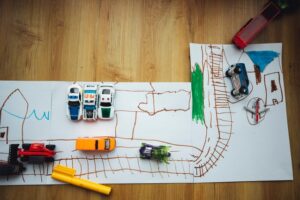Last month, Sean Trezise told us about the minefield of naming and bringing up a child in a very multilingual environment; continuing our informal ‘Parents of Eltabb’ series this month, Sherri Williams has discovered what it’s like to put down the Powerpoint, lower the register a notch or two and make an emergency diversion far, far away from the world of business English…
I’ve worked as a Business English trainer in Montreal and Berlin for the past 8 years, teaching professionals of all levels and backgrounds. But on the evening of September 30, 2019, I started a new long-term contract teaching a first language to a very special client – my baby daughter Becca.
Her natural curiosity and zest for life means I don’t have to do very much active teaching, but here are some strategies that I found have an interesting crossover and work well with both her and the adults I teach.
Use visuals
Inspired by a friend’s experience many years ago, we started teaching Becca baby sign language at around 4 months old, beginning with simple words like “milk” (squeezing one hand like you’re milking a cow) and “more” (making two fists with thumbs up and knocking your knuckles together).
Long before she could form words with her mouth, she used the signs to tell us what she wanted, which I think helped her feel much more in control of her learning.
Now that she is 2 years old and can speak very well, she doesn’t use the signs anymore, but every once in a while when she wants to emphasize something, she’ll talk with both her hands and her voice!
Visuals and gestures linked to target language can also help adults, as our visual memory is usually stronger than our auditory memory.
Repeat, repeat, repeat
Toddlers naturally like to repeat things they enjoy, which is super helpful for language learning. Becca started off picking out key words and repeating them, then copying our phrases, sometimes picking up the oddest things to repeat over and over!
She also loves to give us our “lines” – she’ll do something comical, like walk down the hallway wearing my slippers and then say, “What are you doing with Mommy’s slippers?” because that’s what we said the last time. The only downside to this is she uses “you” and “your” instead of “I” and “my” when referring to herself because she’s copying exactly what we say!
Becca also loves learning so much that when I give her an explanation of something she’ll often say “Talk about that again, Mommy!” and will eagerly listen to the whole thing all over again.
While adults often get bored and want to move on to the next thing, repeating the content by asking questions about it can help keep it fresh.
Make it fun
You can’t force a toddler to do anything they don’t want to do, so the best way to motivate them is by making it into a game, a song, or by including a fun action.
Becca loves music, so the first strings of words she could say were song lyrics (again, the advantage of repetition comes into play as well, as she wants the same songs sung to her over and over again).
She also has a flair for the dramatic and loves when language is paired with actions. In preparation for her meeting some new kids at her German Kita, I taught her to say “Wie heißt du?” (“What’s your name?”) and gestured to her with an open hand, indicating she should respond with her name.
Well, she thought that was the best game ever and proceeded to make an exaggerated sweeping gesture, using her whole arm to engage first Daddy, then Mommy, then Grandpa and Grammie with a very well-pronounced “Wie heißt du?”
Adults may not think games are “serious enough” for their training courses, but having fun while learning does wonders for language retention.
Use chunks and set phrases
Though we have explicitly taught her some phrases (“please”, “thank you”, “Can I have some ___, please?” and the more frivolous “Pretty please with sugar on top”), most of her lexicon comes from repeating things she hears other people say.
We always repeat the phrases back to her after she uses them, so she hears them again and knows she has used them correctly. Learning the context for using them comes next, though this is a natural consequence of hearing language used in the real contexts she wants to participate in.
Likewise, it’s important that adults learn language they are actually going to use in their real lives and not just lists of words and phrases that won’t be useful to them.
Practice, practice, practice
One advantage Becca has as a language learner is that her target language all centers around her daily activities. Contrary to adults trying to learn a foreign language for many different purposes all at the same time – everything from making small talk to giving business presentations to discussing world news – Becca’s world is limited to activities around the house and her small circle of friends and family.
Therefore, she gets a lot of opportunities to practice the same contexts over and over. One thing I do is take photos and videos of her during the day and post them to a family WhatsApp group. Then we have a daily video call with her grandparents over dinner, in which they ask her questions about her day, based on the photos they’ve seen.
So she gets to repeat the language she heard earlier and practice it in a different context, answering questions about the same topics.
Use CCQs to check understanding
When I have to explain something important to Becca and I want to make sure she’s understood, I use a technique I learned way back in my Celta course days – asking CCQs, or context-checking questions. If I give her an explanation like: “When you ride your bike, we stay on the sidewalk. Then when we get to the corner, you stop and wait for Mommy and Daddy.”
I’ll then check if she understood using questions she has to fill in the answers for. “Where do you ride your bike…on the sidewalk or in the street?” “When we get to the corner, what do you do?”, etc.
Sometimes I also use a finish-my-sentence technique. “We have to stop when the light is ____ (red).” “We can go when the light turns ____ (green).”
With kids, you’re never sure if they’re actually listening or if they’ve understood you, but I find the same goes for adults, who never want to admit they don’t understand!
Recognize the patterns
Before I had a child I couldn’t imagine how a kid could differentiate between two (or more) languages before mastering their first.
How can Becca tell the difference between English gibberish she doesn’t understand yet and German gibberish? But somehow she already has the concept down that different people speak different languages, and can tell which language they are speaking.
She’s great at recognizing patterns. For example, she learned to count in English “one, two, three, four, five, etc.” and then at the playground heard her German friend putting her daughter on the slide and going “Eins, zwei, drei, los!” (“One, two, three, go!”).
Later when I was teaching her to count in German, I asked her to count to five in German and she very confidently said, “Eins, zwei, drei, los, funf!” We had a good laugh over that, but she’s on the right track with the pattern recognition.
All in all, I have found Becca’s process of language learning fascinating. I hope all my future clients are as motivated and enthusiastic as she is, though I doubt I will ever hear them say, “Talk about that again, Sherri!” at the end of a class!









